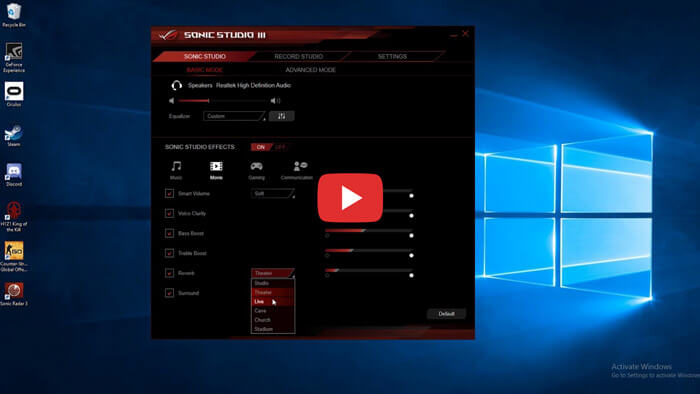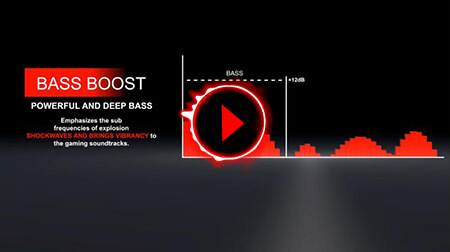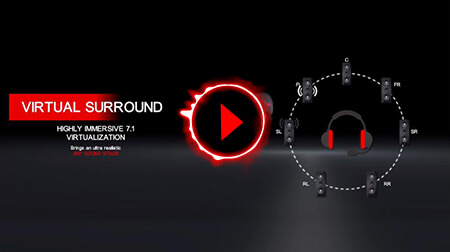Sonic Studio III audio-effects station has an intelligent routing feature made for streaming. The new routing feature ports streams to different outputs giving you full control over who hears what. With Sonic Studio III, you now can share your exciting in-game moments without worrying about frivolous DCMA takedown requests. Sonic Studio III also comes with app-level preferences for instant audio profiles, and improved noise filtering for conversations with total clarity!

-
Sonic Studio III -
Basic ModeSonic Studio III is an audio suite that offers multiple audio controls, ranges from Smart Volume, Bass Boost, Treble Boost, Voice Clarity, Reverb and Surround. Surround is dedicated for 2-channel headset and offers one of the best virtual surround technology for gaming.
-
Sonic Studio III -
Effect DemoSonic Studio GUI offers a range of EQ options, allowing you to tailor acoustics to suit personal preferences for each individual application.
-
Sonic Studio III -
Advanced ModeSonic Studio III is updated from the second generation. The latest feature in Sonic Studio III is the Ultimate Control Center for dorm room audio. The mapping of different audio streams to different output allows audio to be effectively compartmentalized so that it's easy to share with friends or keep to yourself.
-
Sonic Studio III - Routing Demo
Make Sonic Studio your audio control center with the new audio routing feature. The advanced tab allows for quick switching of the default output device and also serves as a central point where you can map different applications to different devices.




Audio station
*Click on the boxes to learn more.

-
ADVANCED MODE - ROUTING
Make Sonic Studio your audio control center with the new audio routing feature. The advanced tab allows for quick switching of the default output device and also serves as a central point where you can map different applications to different devices.

-
SONIC STUDIO LINK
Sonic Studio is now VR Ready with Sonic Studio Link. You can apply Sonic Studio effect directly to your VR headset by enabling Sonic Studio Link.

How it works:
Sonic Studio is defined as an Audio Processing Object (APO) under Windows. Since by definition, APOs must be included in an audio driver, they are limited to only affecting the corresponding device. Sonic Studio Link applies a specially developed technology that allows Sonic Studio to inject its effects onto a third party device. -
SMART VOLUME
Smart Volume keeps a consistent playback level when the user switches between different contents and application sources

How it works:
Smart Volume is a dynamic compression of the sound level (push up the softest sounds, and push down the loudest sounds) -
VOICE CLARITY
Extracts and boosts the frequency of the human voice for crystal clear in-game communications and dialogues in movies.

How it works:
Voice clarity extracts voices mapped to the center panned speakers and then boosts the volume to make dialogue clearer and easier to understand. In the case of 2 channel audio, Voice Clarity acts on the phatom center audio. -
BASS BOOST
Increase the sub-bass and bass frequencies to allow for pounding and punchy beats as well as visceral explosions.

How it works:
Bass boost provides a 0-12dB boost with a corner frequency of 125Hz. The effect is compressor limited to prevent any distortion. -
TREBLE BOOST
Increase the treble frequencies to enhance the clarity of the overall recording strengthening the attack of many percussive sounds, while also increasing the volume of the human vocal range.

How it works:
Treble boost provides a 0-12dB boost with a corner frequency of 2kHz. The effect is compressor limited to prevent any distortion. -
REVERB
Simulates echo effects commonly heard in large halls to create more spacious sounding audio.

-
SURROUND
Virtual Surround processes multi-channel audio with a proprietary algorithm to provide surround sound on 2-channel headphones.

How it works:
The virtual surround effect is 3D virtualization technology based off of a head-related transfer function (HRTF). It is developed by measuring the changes in perceived sound of test tones in a 360 degree field around a dummy head. An algorithm is then developed to simulate these changes with 7.1 audio. Since the efficacy depends heavily on the testing methodology and the properties of the dummy head, Sonic Studio’s algorithm is then averaged with a database of available algorithms to obtain an effective mean for a more balanced virtual surround effect